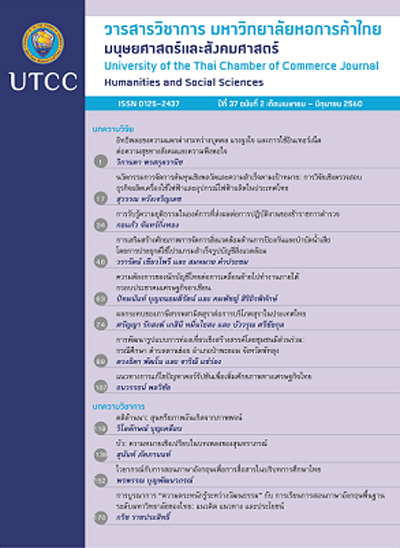Problems and Obstacles of People Who Cycling in Hatyai City Municipality and Khohong Town Municipality, Songkhla Province
Main Article Content
Abstract
The research aimed to study the problems and obstacles of people who cycling in Hatyai City Municipality and Khohong Town Municipality, Hatyai District, Songkla Province. The samples of 400 population were selected by convenience sampling method. A questionnaire was used as a research instrument and t-test and F-test were utilized to analyze the data. The results showed that most of people are do not cycling in daily life (67.5 percents). There are only 32.5 percent do cycling and the objective of cycling is for exercise (24.8 percent). The frequency of cycling are 1-2 days per week (13.8 percent). The cycling distance is about 1.1-3.0 km (9.8 percent) and time of cycling is 15-30 minutes (11.3 percent). The top three problems and obstacles that affected the people to cycling in Hatyai City Municipality and Khohong Town Municipality are feeling unsafety, no bike lane, and no bicycle parking area. But the least problems and obstacles is the feeling of
being looked down as poor people.
Article Details
ลิขสิทธิ์ของบทความ
ผลงานที่ได้รับการตีพิมพ์ถือเป็นลิขสิทธิ์ของมหาวิทยาลัยหอการค้าไทย ห้ามมิให้นำเนื้อหา ทัศนะ หรือข้อคิดเห็นใด ๆ ของผลงานไปทำซ้ำ ดัดแปลง หรือเผยแพร่ ไม่ว่าทั้งหมดหรือบางส่วนโดยไม่ได้รับอนุญาตเป็นลายลักษณ์อักษรจากมหาวิทยาลัยหอการค้าไทยก่อน
References
Boonyoo, T. (2005). Guidelines for development of bicycle system in regional city. Retrieved March 12, 2017, from https://www.thaicyclingclub.org/sites/default/ files/19_ephynphaa.pdf. (in Thai)
Chaowarat, P. (2014). Soft Measure for cycling promotion. In P. Ussahawanitchakit (Ed.),The proceeding of 10th Mahasarakham University research conference (pp. 73-85). Mahasarakham: Mahasarakham University. (in Thai).
Chaowarat, P., & Piriyakarnnon, M. (2013). Walking and bicycling promotion,Mahasarakham University, Kamriang Campus. Retrieved March 12, 2017, from https://www.thaicyclingclub.org/content/general/knowledge/detail/1715.
(in Thai).
Department of Highways. (2015). Guide for development of bicycle facility. Retrieved July 15, 2017, from https://www.ooh5.go.th/CA/CA14.pdf (in Thai).
Forsyth, A.,& Krizek, K. (2011). Urban design:Is there a distinctive view from the bicycle?. Journal of Urban Design. 16(4), 531-549.
Leopairojna, S.K. (2012). Improving access to public transportation for canalside communities near Kasetsart University, Bangkhen. Journal of Architectural/Planning Research and Studies, 8(2), 27-49. (in Thai).
Modus Consultants Co., Ltd. (2008). The Project of Lay Out and Development Plan to Support the Expansion Area.Bangkok, Thailand: Department of Public Works and Town and Country planning. (in Thai).
Nuworsoo, C., Cooper, E., Cushing, K., & Jud, E. (2012). Considerations for integrating bicycling and walking facilities into urban infrastructure. Retrieved January 15, 2017, from https://docs.trb.org/prp/13-3997.pdf
Panswad, T., Nugnan, P., Jewtan, B., Na Nakorn, W., Choothong, S., Thawewut, T.,..., Songkittipakdee, V. (2012). Factors affecting the decision on bicycle daily uses in Thailand for bike users. Retrieved March 12, 2017, from https://www.thaicyclingclub.org/sites/default/ (in Thai).
Phoochinda, W. (2012). Implementation of the sufficiency economy philosophy of environmental management in the
manufacturing industry. University of theThai Chamber of Commerce Journal, 32(2), 1-16. (in Thai).
Pittungnapoo, W., Panswad, T., Nugnan, P., Jewtan, B., Na Nakorn, W., Choothong, S.,..., Songkittipakdee, V. (2554). Factors affecting the decision on bicycle daily uses in Thailand for bike users. Retrieved
February 11, 2017, from https://www.thaicyclingclub.org/sites/ (in Thai).
Ruansorn, P. (2003). A communal bicycle way planning criteria: A case study on the neighborhood surrounding King Mongkut’s Institute of Technology Ladkrabang. Bangkok, Thailand: King Mongkut’s Institute of Technology Ladkrabang.
(in Thai).
Siriin, P. (2014). Bicycling network develpoment in Salaya municipality. Retrieved March
18, 2017, from https://www.thaicyclingclub. org/sites/default/files/17_phlchay.pdf (in Thai).
Srisurapanon, V. (2014). Management of bicycle parking. Retrieved February 15, 2017,from https://www.thaicyclingclub.org/sites/default/files/25_rs.dr_._wiorcchn.pdf (in Thai).
Srisurapanon, V., Tangtongjit, M.P., Kiatpanachat, K., Artaong, P., Limsuttirat, P., & Luangsirinapa, P. (2003). Guideline for improvement the usage of bicycle in Bangkok. Bangkok, Thailand: The Thailand Research Fund. (in Thai).
Thaenlek, N. (2013). Passenger transport and in a low carbon society: A case study Hat Yai municipality (Unpublished
master’s thesis). Prince of Songkla University, Songkla, Thailand. (in Thai)
Tiangtrong, T. (2014). Cycling behavior in inner city, urban fringe and suburban of Bangkok. Academic Journal of
Architecture, Chulalongkorn University, 19,559-565. (in Thai).
Wiriyapipat, N. (2015). ISO 50001: A sustainable energy management system. University of the Thai Chamber of Commerce Journal. 35(2), 185-203. (in Thai).
Yamane, T. (1967). Statistics: An introductory analysis. 2nded. New York, N.Y.: Harper and Row.


